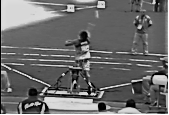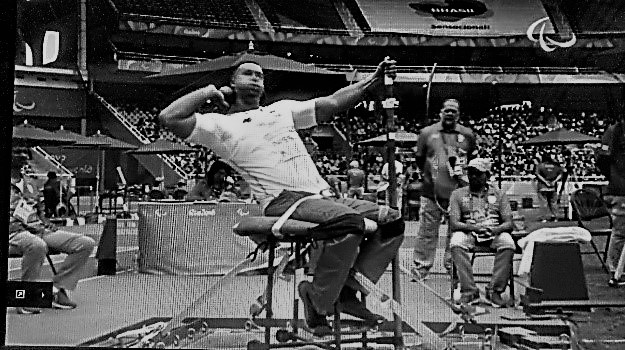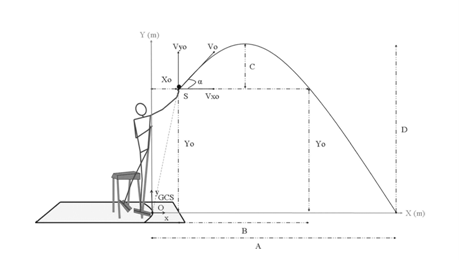-
Paper Information
- Paper Submission
-
Journal Information
- About This Journal
- Editorial Board
- Current Issue
- Archive
- Author Guidelines
- Contact Us
International Journal of Sports Science
p-ISSN: 2169-8759 e-ISSN: 2169-8791
2019; 9(2): 25-27
doi:10.5923/j.sports.20190902.01

Shot Put Regulations Changes and Implications in Physically Challenged Athletes Performance
Gilberto Martins Freire1, Gabriel Lucas Morais Freire2, Dalton de Lima-Junior2, Graciele Massoli Rodrigues3
1Department of Education, Universidade Tecnológica Federal do Paraná and Universidade São Judas Tadeu, São Paulo, Brasil
2Department of Physical Education, Universidade Federal de Pernambuco, Pernambuco, Brasil
3Graduate Program Coordination of Physical Education, Universidade São Judas Tadeu, São Paulo, Brasil
Correspondence to: Gilberto Martins Freire, Department of Education, Universidade Tecnológica Federal do Paraná and Universidade São Judas Tadeu, São Paulo, Brasil.
| Email: |  |
Copyright © 2019 The Author(s). Published by Scientific & Academic Publishing.
This work is licensed under the Creative Commons Attribution International License (CC BY).
http://creativecommons.org/licenses/by/4.0/

Context: The 2014 regulation establishes a new stance to a seated thrower athlete that prevents the performance of sports movements based on functional capacities. Objective: To analyze changes in regulations and discuss their interference in a group of Paralympic athletes. Method: This is a descriptive documentary research that used track and field International Paralympic Committee (IPC) regulations (2013 and 2014) archives and specific academic articles related to that discipline. Results: The Throwing frames conception according to the new rules will restrict the functional potential and performance of a group of athletes that change from F58 to F57 class. Conclusion: The changes in the rules did not take into account the long period of training; the work developed by the coaches; the research in the area, as well as, the extent of the athletes functionality in this sports classification.
Keywords: Shot put, Athlete with disability, Rules, Throwing frame, Performance
Cite this paper: Gilberto Martins Freire, Gabriel Lucas Morais Freire, Dalton de Lima-Junior, Graciele Massoli Rodrigues, Shot Put Regulations Changes and Implications in Physically Challenged Athletes Performance, International Journal of Sports Science, Vol. 9 No. 2, 2019, pp. 25-27. doi: 10.5923/j.sports.20190902.01.
1. Introduction
- Historically, wheelchair activities in Paralympic games had a pivotal position that revealingly enhanced competition levels (Woude et al., 2004). The participation of people with disability in sports activities keeps gaining popularity and becomes like the height for many of them (Keogh 2011). Lots of clubs, athletes, and sports modalities are being supported by the growing participation of countries, athletes, professionals, viewers, and media coverage in countless international competitions (Freire & Rodrigues, 2015).The complexity of wheelchairs sports challenges the scientist in a unique way, as two main components contribute to their performance: the athlete and the throwing frame, whose interaction allows necessary sports movements (Goosey & Prince, 2010). Huge progress is recorded annually, as well as levels of performance enhanced substantially based on better physical conditioning, technique, tactical awareness and science (Mason et al., 2013). The throwing frame for people with impaired lower limbs was one of the accessories designed to ease sports activity that is widely spread around adapted track and field environment, and where the athlete uses it as body extension to perform an activity. This study focused on changed rules and discussion about their interference in a group of Paralympic athletes.
2. Method
- This is a descriptive documentary research approved by the São Judas Tadeu (act Nº 684.204) University Ethical Committee and Research. It used data from the International Paralympic Committee (IPC) regarding track and field regulations (2013 and 2014) for people with physical disability, and specifically regulation 35 on requisites for throwing frame along with specific academic articles in that area.State of artAthletes must use a personal throwing frame during shot put competition. Each seated thrower adjusts his or her own equipment to better reach a functional capacity and allows maximal performance (O'Riordan & Frossard, 2006).A throwing frame allowing support and stability, as well as helping athletes to get a better shooting position is essential to those with good functional dosages on limbs. Thus, the interaction between athlete and throwing frame, including how it can influence performance is critical to the coach (O'Riordan & Frossard, 2006).The group of athletes unable to stand on their feet or have problems with balance and stability that hinder a shot while standing is also included here. Therefore, a throwing frame with aspects involving some parameters regarding its conception and athlete positioning is conceived, then used according to IPC regulations. In 2013 a regulation stipulated that a group of competitors F34/F57 e F58 (athletes with cerebral palsy, poliomyelitis, amputations and other cases) must start a shot or throw on seated position, and if the athlete were to be standing, he or she must keep one foot in contact with the ground inside the circle until the instrument is released. The first movement before the shot is considered the starting point. Athletes who belonged to F34, F57, and F58 functional classes managed to perform their shots whilst standing (figure 1).
 | Figure 1. Athlete completing shot put whilst standing (Source: Rio de Janeiro 2007 Para Panamerican Games) |
 | Figure 2. Athlete in determined posture as stipulated by the 2014 change in regulation (Source: Rio de Janeiro 2016 Paralympic Games) |
3. Results and Discussions
- Appliances like prosthesis and wheelchairs are critical to allow some people with a disability perform tasks daily (Haisma et al., 2006). Advances in technology help attaining high performances. Oscar Pistorius was able to potentially classify for the men 400m at the Olympics and Paralympics Games in 2008 due to his skills and the newest prosthetic technology (Burkett, 2010).The relation between predetermined performance as to trajectory parameters at the moment of release, that is, the positioning, the angle and speed in athletes that accomplish their shot whilst standing is illustrated here (figure 3).
 | Figure 3. Initial characteristics of the trajectory of the shot at the moment of release (Source: Curran & Frossard (2012)) |
4. Conclusions
- The changes in the regulation did not take into account the work developed by the athletes and coaches along the years and their training while considering the conception of seats adjustable to the functional skills of their athletes. The F58 sport functional class competitor migrated to class F57, which may compromise the competition fair play, considering that the group F58 has a greater functional capacity. This occurrence may also trigger lack of motivation in the group F57, whose athletes are more physically committed. This activity suggests an error, which may point that the adopted sports artifact must be suited to increase the capacities of its users instead of restricting them. Finally, this study indicates that the changes in the regulation may restrict the technical movements of the athletes, which may suggest a change in their performance.ResumoIntrodução: O regulamento de 2014 estabelece uma nova postura para um atleta de arremesso sentado que impede o desempenho de movimentos esportivos com base nas capacidades funcionais. Objetivo: Analisar as mudanças na regulamentação e discutir sua interferência em um grupo de atletas paralímpicos. Método: Trata-se de uma pesquisa documental descritiva que utilizou os arquivos de atletismo do Comitê Paralímpico Internacional (IPC) (2013 e 2014) e artigos acadêmicos específicos relacionados a essa disciplina. Resultados: A concepção dos bancos de lançamento com novas regras restringe o potencial funcional e o desempenho de um grupo de atletas. Conclusão: As mudanças desconsideraram seus anos de treinamento, treinadores, pesquisadores da área, bem como o grau de funcionalidade dos atletas nessa classificação esportiva.Palavras-chave: atleta com deficiência, regras, armação de arremesso, desempenho.
 Abstract
Abstract Reference
Reference Full-Text PDF
Full-Text PDF Full-text HTML
Full-text HTML